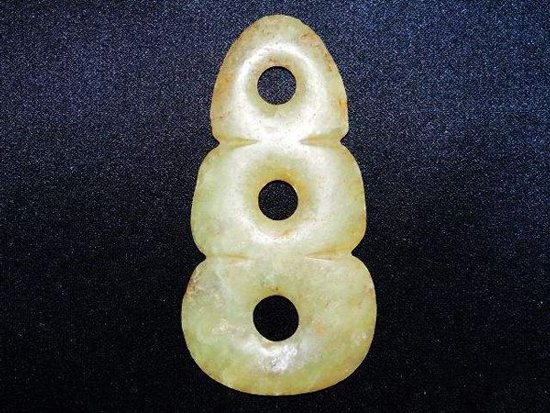In Shangzhi County, Heilongjiang Province, there is a site of the Neolithic cultural relics, Yabuli, which is about 5,000 to 4,000 years old. Here, many pottery, stoneware and jade articles have been unearthed, and one of them is a rare jade, attracting the attention of many archaeological excavators. This eye-catching jade is called "Sanlian Yuxi" and is now in the Heilongjiang Provincial Museum. The so-called joint is to connect two or more jade in a cross-link or vertical joint to form a jade. This piece of Sanyu jade is made up of three pieces of jade, which is 9.5cm long, 3.1cm wide and 5.0cm wide. It is a small trend. There are three round holes in the middle of the body, and there are two obvious recesses on both sides of the body; the upper end is semi-circular, the middle and lower ends are slightly rounded, and the inner and outer edges are thin and blade-like. The jade was originally a flat circular jade with a hole in the middle. With the passage of time, its shape changed slightly, not only with round jade, but also with square jade and joints. In "Zhou Li", there have been records: "Jade is used as a six-piece, to the heavens and the earth, to the heavens and the earth, to the sky, to the heavens; to the yellow rites; to the Qing dynasty to the east; to the red rites to the south; to the white to the west; Xuan Zang Li North. "It can be seen that Yuxi is one of the six great ritual jade, and for the ancient Chinese people who attached great importance to the ritual ceremony, its importance is self-evident, and even symbolizes the power status of the royal family. As for its use, it is both a must-have for the sacrifice ceremony and a beautiful piece to wear and give to others on weekdays. Because the Sanlian jade in the Heilongjiang Provincial Museum is collected, it cannot be accurately inferred for its functional use. However, in the Hongshan culture of Liaoning, similarly shaped jade plaques have been found. From the perspective of excavation location, shape characteristics and the religious beliefs of Hongshan culture, its functions are diverse, it is used for decoration and wear, and it is natural worship. Symbol is a symbol of reproductive worship. Whether the Sanlian jade collected by the Yabuli site has the functional use of the Hongshan culture jade, whether there is a connection between the Heilongjiang Neolithic culture and the Hongshan culture, it is still impossible to verify, and there may be new archaeological discoveries in the future. For research. Woven Print,Printed Woven Fabric,Woven Print Fabric,Printed Non Woven Fabric SHAOXING KAIMING TEXTILES CO.,LTD , https://www.kaimingtextiles.com